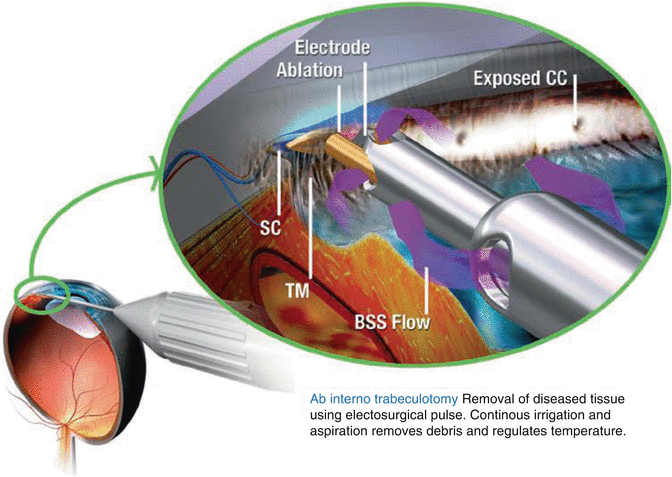Fig. 28.1
Glaukos trabecular iStent (Courtesy of Glaukos Corp., Laguna Hills, California)
Another technique removes an arc of trabecular meshwork and inner wall of Schlemm’s canal via electro-ablation with simultaneous infusion of fluid and aspiration of tissue debris (NeoMedix, Trabectome, Fig. 28.2).
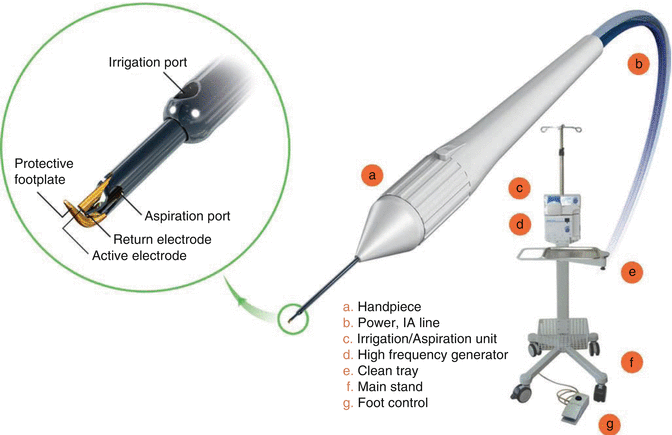

Fig. 28.2
Trabectome surgical unit and handpiece (Illustration courtesy of NeoMedix, Tustin, California)
Developing a Microstent
The concept for the iStent was developed from the observation that trabecular tissues would fill in to apposition after injury or focal removal. The iStent is actually a family of devices to enhance the physiologic outflow of the eye. This device makes a bypass opening in the trabecular meshwork and allows trabecular meshwork to fill into the edge of the device inlet but prevents closure of the opening (Figs. 28.1 and 28.3).


Fig. 28.3
In vivo goniophotograph of the first iStent implantation, 6 months postoperatively (Courtesy of Glaukos Corp., Laguna Hills, California)
The development of the trabecular stent was not possible until recent engineering improvements in micromachining. The size of the device is based on the scale imposed by the trabecular meshwork and Schlemm’s canal. The iStent, which resides in the lumen of Schlemm’s canal, is 1,000 μm long and 250 μm in width. It has an open, arched body (Fig. 28.1). The iStent design is intended to perform two functions: providing direct access of aqueous into Schlemm’s canal from the anterior chamber (the snorkel effect) (Fig. 28.4) and pushing the anterior trabecular meshwork away from the posterior wall of Schlemm’s canal, where aqueous collector channel openings are located. The arch precludes occlusion of a collector channel opening should it lie behind the iStent (Fig. 28.5).
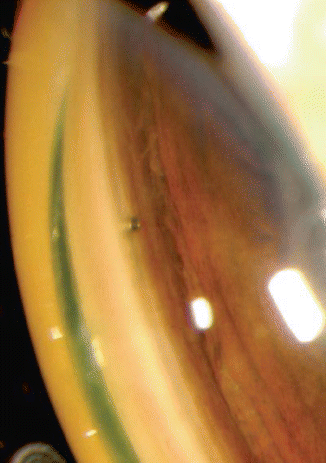
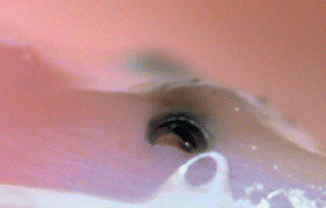

Fig. 28.4
In vivo goniophotograph 6 months postimplantation. Note trabecular meshwork has filled in to edge of snorkel and stopped (Courtesy of Dr. Jonathan Meyers, Wills Eye Hospital)

Fig. 28.5
An iStent implanted in eye bank tissue, showing stenting of Schlemm’s canal (Courtesy of Glaukos Corp., Laguna Hills, California)
The device is self-trephining with the aid of an angled tip and open in its tail portion to allow for bidirectional flow. The arch portion of the device also has elevated retention features to limit movement or backing out (self-retaining) from its placement in Schlemm’s canal. The device is made out of medical-grade titanium (6AL-4V) and is heparin coated (Duraflo). The weight is approximately 60 mg, and mirror image left and right eye devices are required because of anatomical considerations.
Surgical Techniques
Both procedures (Glaukos iStent or Trabectome) can be performed either as a stand-alone surgery or in combination with cataract surgery. Trabecular surgery may be performed before or after phacoemulsification as there can be a decreased clarity of the tissue overlying the corneal wound after removal of very dense nuclei which can decrease the clarity of the view.
Gonioscopes were designed (by one of us, RAH) in conjunction with Ocular Instruments (Bellevue, Washington) for both procedures (Fig. 28.6) and provide excellent wide-angle views. Both lenses are modified Swan-Jacobs direct gonioscopes for comfortable right- or left-handed manipulation with an elongated handle moved to the side of the lens. On the side facing away from the surgeon, a metal flange facilitates stabilization of the eye and negates the need for traction sutures.
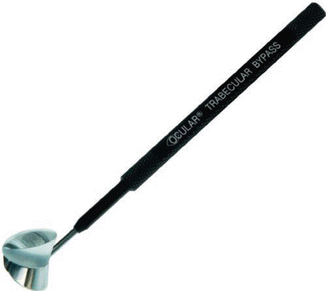

Fig. 28.6
The trabecular bypass surgical gonioscope (Courtesy of Ocular Instruments, Bellevue, Washington)
After the creation of the corneal wound, viscoelastic may be instilled into the anterior chamber to deepen it. This allows excellent access to the filtering angle and maximizes the safety in phakic adult and pediatric patients. Alternatively, the Trabectome handpiece includes an infusion sleeve for continual irrigation and chamber deepening with balanced salt solution, which is the ideal environment for ablation.
The Trabectome surgical pack includes a Simcoe irrigation cannula for use if necessary to ensure removal of all viscoelastic after angle surgery. For iStent, the applicator/handpiece tip is advanced through the wound up to the pupillary margin and the gonioscope placed on the eye. For both procedures, the patient’s head should be tilted away at approximately a 45° angle and the microscope body and oculars adjusted toward the operator as necessary to optimize the view. Taping the patient’s head is avoided to allow head adjustments intraoperatively. With the gonioscope on the eye, a light touch is used to view the filtering angle. Care should be taken not to indent the cornea as this distorts the view. The site for surgery is selected based on surgery and lens implantation. Potential advantages of angle surgery first before cataract surgery include greater clarity of the peripheral cornea for improved visualization of the filtering angle. In addition, reflux hemorrhage, highly likely, with either can be easily removed during the cataract removal. Both surgeries are started by making a small, temporal, clear corneal incision, with a 15° knife or appropriately sized keratome. This incision is made as close to the limbus as possible to prevent lifting of the gonioscope on observed positions of external aqueous vein complexes (Fig. 28.7) and areas of increased trabecular pigmentation. Aqueous veins may originate with a “C” or “S” shape at the limbus, and their episcleral portion tends to be more linear in which trilaminar flow often can be seen. The large aqueous vein complexes are usually found at 3:30 and 8:30, inferior nasally, in the right and left eyes respectively [3]. The areas of increased trabecular pigmentation are a clinical sign that large collector channel ostia are in proximity [4]. Finding these structures preoperatively will give an approximate position for surgery that will give maximal access to the outflow structures.
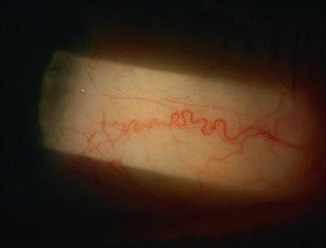

Fig. 28.7
A large aqueous vein at approximately 3:30 in a right eye. The origin is “C” or “S” shaped – they tend to be more linear and trilaminar flow can be seen (Courtesy of Glaukos Corp., Laguna Hills, California)
Viscoelastic support of the anterior chamber at a hypotonous pressure leads to congestion of Schlemm’s canal, aiding in its identification.
iStent Implantation
The iStent is held by the applicator (Fig. 28.8a, b) outer tubing, which is 26-gauge stainless steel, from which extend four micromachined fingers from a smaller tube securing the device by the inlet tube. This applicator can also be used to reposition a stent or to reacquire a stent during surgery. The distal, pointed end of the iStent is inserted through trabecular meshwork in a penetrate, lift, and slide insertion technique (Fig. 28.9). The angle of attack is approximately 15°, and the stent is passed through trabecular meshwork at a position of about one-half of the way down the pigmented portion of the trabecular meshwork band (uveal-scleral meshwork). The initial penetration usually goes through trabecular meshwork and the inner wall of Schlemm’s canal lodging in the outer wall of Schlemm’s canal. At this point, there is a definite sticking sensation and the eye itself can be moved without the implant advancing. A small lifting or a small backing motion is utilized to disengage the posterior wall of Schlemm’s canal, and a sliding motion is then used to advance the device into Schlemm’s canal. Once this has occurred, the release button on the applicator is pushed and the applicator fingers holding the snorkel of the device are released.



Fig. 28.8
The iStent is held by the applicator tubing, which is 26-gauge stainless steel from which extend (a) four micromachined fingers from a smaller tube (b) securing the device by the inlet tube (Courtesy of Glaukos Corp., Laguna Hills, California)

Fig. 28.9
The pointed end of the iStent is inserted through trabecular meshwork in a penetrate, lift, and slide insertion technique
At this part of the implantation sequence, the heel of the device compresses trabecular meshwork focally and the implant is not locked into Schlemm’s canal. Using the applicator, the device must be advanced slightly further to allow the heel to pass beyond trabecular meshwork and the body of the device to sit entirely within Schlemm’s canal (Fig. 28.10a–e).
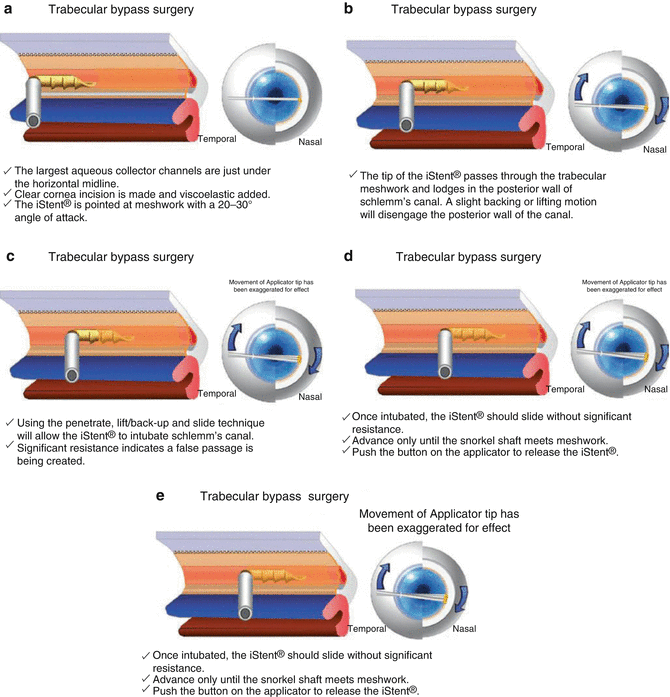

Fig. 28.10
(a–e) Implantation sequence of the Glaukos iStent (Courtesy of Glaukos Corp., Laguna Hills, California)
This is accomplished by pushing on the snorkel of the device with the tip of the empty applicator. Reflux of blood may not occur at this point in time as it is tamponaded by viscoelastic in the anterior chamber. When the operator is sure that the device is in the correct position, the applicator is withdrawn from the eye and viscoelastic is removed by irrigation with balanced salt solution. If there is doubt on the correctness of the implantation, the device may be reacquired by the applicator and another site chosen for implantation. The gonioscope is then replaced and the device viewed.
Trabectome Trabecular Ablation
The Trabectome handpiece – currently cleared for single use only by the US Food and Drug Administration (FDA) – includes a foot-pedal-controlled infusion sleeve and an aspiration function (Fig. 28.2). The tip of the handpiece is passed through trabecular meshwork in a compression and rotation maneuver, using primarily visual clues. Gentle compression of the mesh creates a fold into which the tip can be rotated. The Trabectome tip incorporates an electro-ablation function utilizing a spark between active and return electrodes, shielded from the posterior wall of Schlemm’s canal by the ceramic coated footplate. The footplate acts as a guide within Schlemm’s canal as the handpiece is rotated. Simultaneous aspiration removes tissue debris, and infusion both maintains the anterior chamber and provides cooling as additional protection from thermal injury to adjacent tissues (Fig. 28.11). Most Trabectome surgeons are attempting to treat for at least 3 clock hours (Fig. 28.12).

